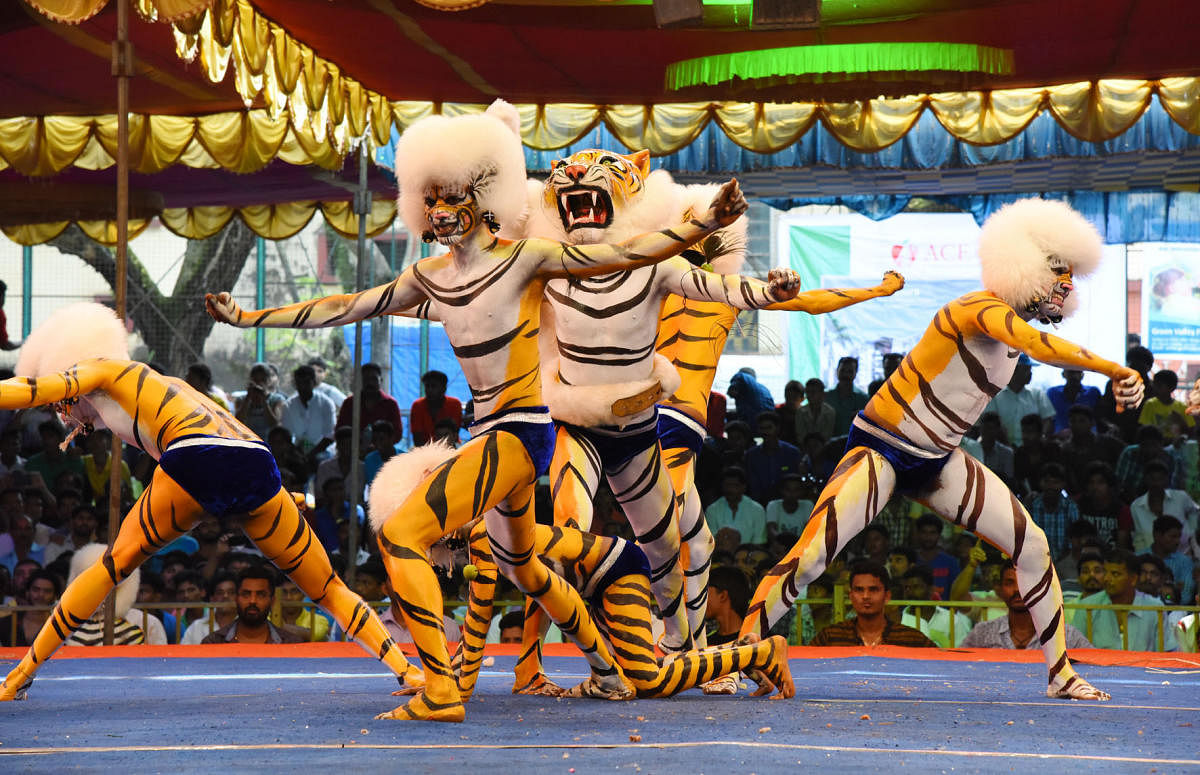The festivities of Navaratri and Janmashtami in Dakshina Kannada and Udupi districts are incomplete without huli vesha or pili vesha (tiger dance) performances. During Navaratri, the tiger dance is a cynosure of eyes across the streets in this district.
Growling and prancing to the rhythms of thaase or himmela, a set of two or three drummers, the ‘tigers’ roar on the streets as hundreds of onlookers cheer. Troupes with about eight to 10 ‘tigers’ and ‘cubs’ go around the streets, accompanied by drum beats, they perform in front of temples, houses and shops for about 10 minutes. After the performance, the troupe is offered voluntary donations by the onlookers.
The main attraction of the huli vesha is the traditional dance steps performed by the artiste. Huli vesha performer, Shivappa, said that at one point he danced for two continuous hours. ‘‘I started performing this dance when I was five years old. After performing for decades, now, I teach the art form to the students, including women,’’ he says. Shivappa also trains students from Andhra Pradesh, Kerala and Tamil Nadu.
Recalling how he came about to performing the art, he says that his guru, K Krishnappa, approached his father and sought his permission to let him learn the dance. ‘‘Once I started, there was no looking back. I performed continuously for 54 years.’’ Adding that, ‘‘I follow the traditional Udupi style. It is rather simple, without any reverse jumps, flips or acrobatic movements. I have always been performing the traditional dance steps and I teach the same to the younger generation, who’ve shown a keen interest in learning the form.’’
There are four types of huli vesha. The various colours used in it are white, orange, yellow and black. These colours are painted all over the body of the artiste along with the stripes.
“The painting of the body begins a day before the performance after paying obeisance to God by offering coconuts and seeking the blessings of the elders in the family. If the performer is getting ready for Janmashtami, then the paint is kept on the body for two days. We drink a lot of tender coconuts to keep our body cool and to avoid the burning sensation,” says Shivappa.
The body paint had a caused a few skin allergies in the past. Even today, some artistes suffer from the effects of the paint. Earlier, the performers would sleep on plantain or colocasia leaves for relief from the burning sensations. However, today the quality of paints used has improved and as a result, the effects are not as bad as they used to be in the earlier days.
Dakshina Kannada and Udupi districts.
It takes about three hours to paint the body of the performer. Generally, the face and the body are painted with various stripes and colours to represent tigers, cheetahs, panthers and leopards. After the performance, the paints are removed using kerosene and oil, says Viju, who heads a huli vesha troupe. Today, the tiger dance has evolved and consists of fire-breathing, gymnastics, bending backwards, hand-walking, handstand and lifting akkimudi (rice tied in straw) with the teeth and throwing it backwards. “Our troupe performs only for a day in tableaux. The expenditure for the same comes up to Rs five to six lakhs,’’ he says.
Traditional tribute
Tiger dance is performed as a tribute to the vehicle of Goddess Durga. An unwritten rule for the performers is that they must not consume alcohol or non-vegetarian food during the performance period.
In the earlier days, the performer would bite a sheep and toss it in the air. However, such practices are banned now and akkimudi has replaced the sheep. Over the years, the performance has become acrobatic and there is an emphasis on stunts, say the traditional performers. That apart, these dance troupes not only perform in Dakshina Kannada and Udupi districts but also outside the state, and in places like Qatar and Dubai. Though the dance form is going places, the traditional performers rue about the lack of dedication among the present day enthusiasts. They say that most of the dancers are not as devout or committed.
Lalithraj Mendon, president of Mangaladevi Hulivesha troupe, says, “Our team is given prominence during Navaratri procession of Mangaladevi Temple and Bolara Sri Mariamma Mahishamardhini Temple. Through the team, small children have been performing the art as a vow to the goddess every year.”
Further, he added, “Our team had performed at Germany and France in 2000.’’
This September, Avighnavyaghra, a team of 19 members of which 16 were girls, performed at the Janmashtami festival in Udupi. The members were part of a Ganeshotsava Samiti in Kadiyali and were trained for 19 days by Shivappa. Navya, one of the team members, says, “It was a wonderful experience. I had been attracted to huli vesha since childhood. For a few days, we were finding it difficult with the dance step, later, we could manage it.”
The objective of the team was to raise funds with their performance and provide it to the Asare Charitable Trust run by the samiti. “We raised money through our performance with the sole intention of meeting educational expenses of the children in the trust,” she said.
“We had painted on our palms and legs for the performance and wore a dress to represent tigers,” she said. Adding, ‘‘The performance went smoothly and we did not experience any allergies.’’
That said, huli vesha continues to be a rich cultural form of expression that represents the festive season.
